Checkpoint Charlie
‹ Return to Berlin

Checkpoint Charlie, Then and Now.
Friedrichstrasse, Berlin, looking towards the Soviet tanks.
October 1961 and December 2013. This is not an exact composite, there were no buildings in the old photo still visible in 2013 for me to align the point of view.
October 1961 was the only time Soviet and US forces squared up to each other at close proximity. The incident led US President Kennedy and Soviet Premier Khrushchev to realise that, important though Berlin was, it was not worth risking nuclear conflict over. (See below “High Noon in Friedrichstrasse”)
Following WWII, Germany was divided up between the western capitalist Allies of USA, UK and France and the communist Soviet Union. Berlin was an island in the Soviet side of Germany and was itself divided between the 4 Powers.
Allied Checkpoint Charlie was the only crossing point for foreigners into east Berlin. Checkpoint Bravo was on the outer border between west Berlin and East Germany and Checkpoint Alpha was at the other end of the autobahn.
BELOW; Transit routes across the DDR

BELOW; Berlin’s Allied frontier crossings

History of the Berlin Wall
While the country border between East Germany (DDR; Deutsche Demokratische Republik) and West Germany was well guarded, those in the East could easily travel to Berlin where there was no guarded border and they could cross to West Germany and stay there or return to the East as they wished. Having people leave for the capitalist west was an embarrassment to Khrushchev and those who earned money in the west but lived in the east were traitors in East German President Walter Ulbricht’s eyes.
Always wanting to force the Allies to leave Berlin for good, Ulbricht planned to sign a peace treaty with Khrushchev which would free the DDR from Soviet control and would give him the right to refuse permission for the Allies to cross East German air space and end the right of foreigners to cross to Berlin along the transit routes.
Khrushchev had previously given the Western Allies an ultimatum; leave Berlin or be forced out. The response from the western Allies, predictably, was a refusal to leave. Germany had been defeated by them, they were the occupying forces and they had a right to be there.
So securing the Berlin border was Ulbricht’s first move preparatory to the peace treaty between the USSR and East Germany. It would put an end to the exodus of young East Germans to the West which Wikipedia puts at 3.5million (20% of the East German population) until the border was closed overnight on 13 August 1961. Unfortunately for Ulbricht, it also removed the need for Khrushchev to sign any peace treaty, enabling the USSR to keep the aggressive Ulbricht in check.
BELOW; Nikita Sergeyevich Khrushchev in Berlin, 1963
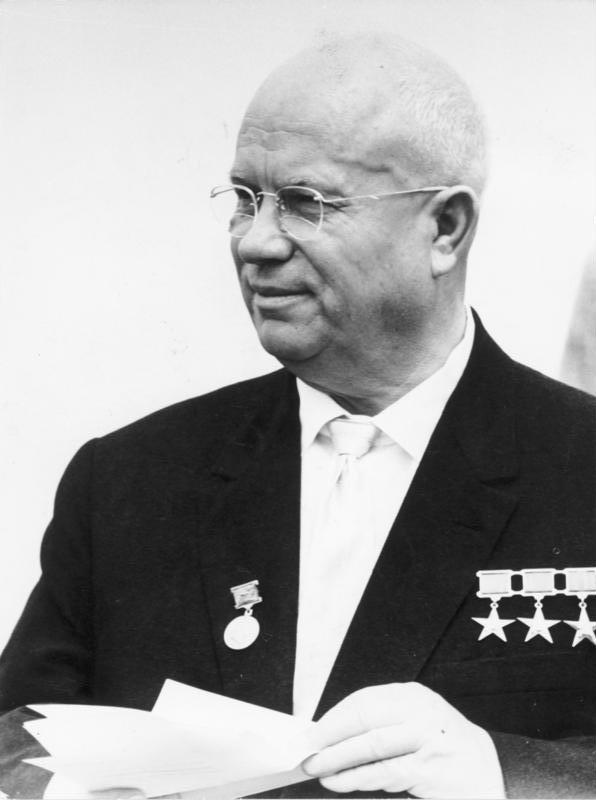
BELOW; “Ich bin ein Berliner”; JFK in Berlin, 1963

BELOW; Walter Ulbricht, June 1961. “No-one has any intention of building a wall”

Immediately barbed wire and anti-vehicle crash barriers were put up across streets along the length of the border and buildings which abutted the border were evacuated by the East German military. While those in the East could no longer leave – the barriers immediately splitting up families – those in the West could still visit the East.
“High Noon on Friedrichstrasse”
The stand-off between American and Russian forces came about two months later when the DDR border guards demanded to see the identity papers of visiting US diplomats. While the British acquiesced and showed their papers, the Americans refused; Germany was under occupation, they were the victors and would not show their papers to the forces of a country whose existence they did not even recognise.
To make the point, visiting US diplomats crossed the Berlin border here at Friedrichstrasse with armed escorts. They refused to show their papers and refused to be prevented from crossing to the east.
BELOW; “Oct. 26, 1961. East German police officers allow the U.S. convoy to cross the border unchallenged.”

Over the following days, the stand-off between US personnel and the border guards increased, with the Americans threatening to use force if necessary to cross. American tanks were brought up, with bulldozers ready to clear away the obstacles. In response, Soviet tanks appeared on the streets of Berlin and faced the Americans at a distance of about 100m. As the situation escalated, each side responded to the other by matching the level of force or threat. One nervous shot could have sparked a catastrophe.

Behind the scenes, Kennedy and Khrushchev seemed confident that would not happen. Agents of both sides were relaying information. Neither the US nor the USSR would fight over Berlin. But neither would leave Berlin either.
Khrushchev knew Kennedy had got himself into a tricky situation, so offered a way out; the Soviet tanks withdrew from the frontier by 5 metres and the Americans did the same. Gradually the Soviet tanks pulled back and into the side streets with the US forces matching their moves and gradually the situation relaxed. It was clear to Khrushchev that the west could live with the Berlin wall. As Kennedy commented, it wasn’t an ideal situation but “a wall is better than a war.”
BELOW; Soviet tanks withdraw from the stand off
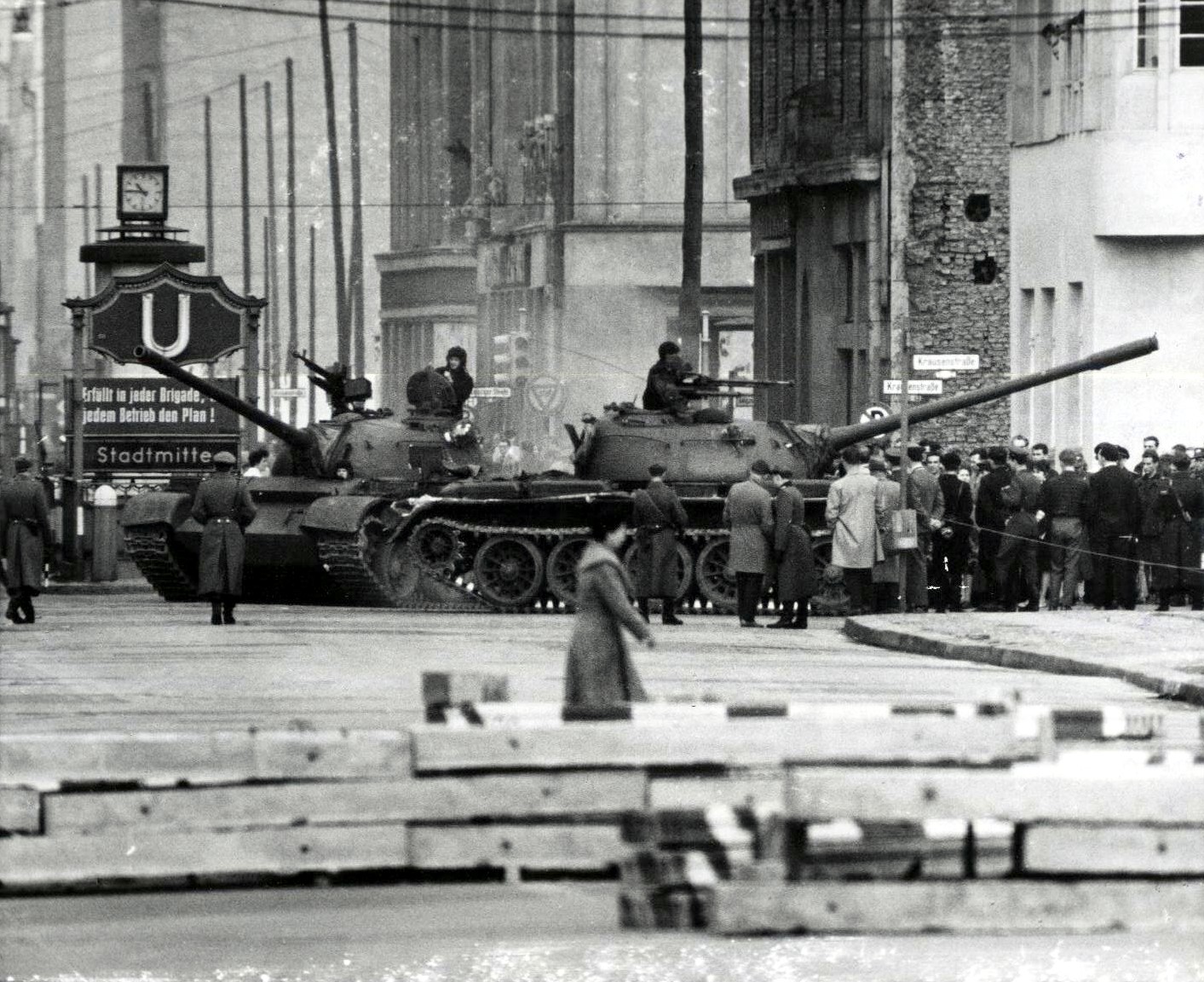
Two years later, Kennedy was assassinated in Dallas and a year after that Khrushchev was ousted by Leonid Brezhnev in 1964.
Ulbricht’s Wall
The border defences grew in strength upon Ulbricht’s order with the building of more obstacles. By the end of its existence what those in the west called the Berlin Wall was just the final hurdle of a series of obstacles anyone trying to escape the DDR would face; high fences – booby trapped and topped with razor wire, anti-vehicle ditches, landmines, guard dogs and watch towers with spotlights and guards ordered to fire on anyone they saw. At least 136 people were killed trying to cross the Berlin Wall.
20 year old Chris Gueffroy was the last person to be shot dead trying to cross on 6 February 1989 (he was shot ten times) while the last to be killed was Winfried Freudenberg on 8 March 1989 (he fell to his death from an improvised hot air balloon).
BELOW; diagram showing escape attempts over a five year period at the border in the country. The controlled area at Berlin was of similar construction. Note the controlled area starts way back from the actual border, the aim was to prevent east Germans getting anywhere near the frontier.
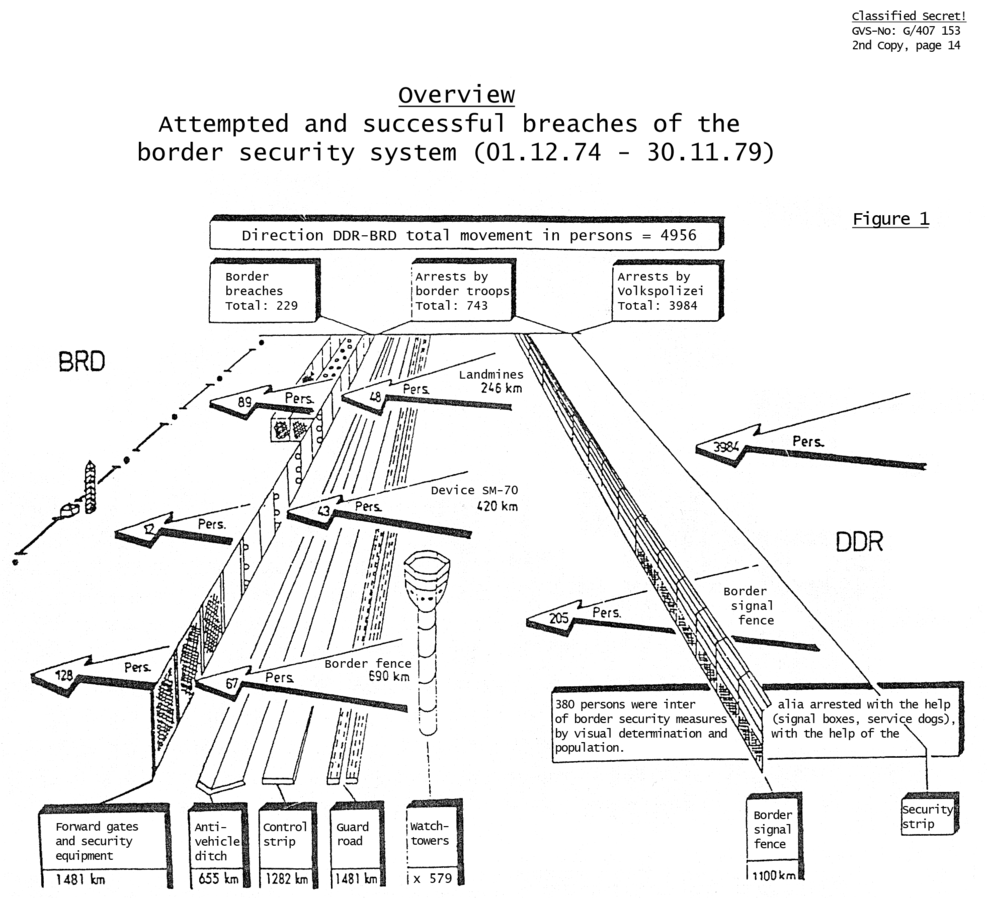

BELOW; Photo of a watchtower I took in the early 90s
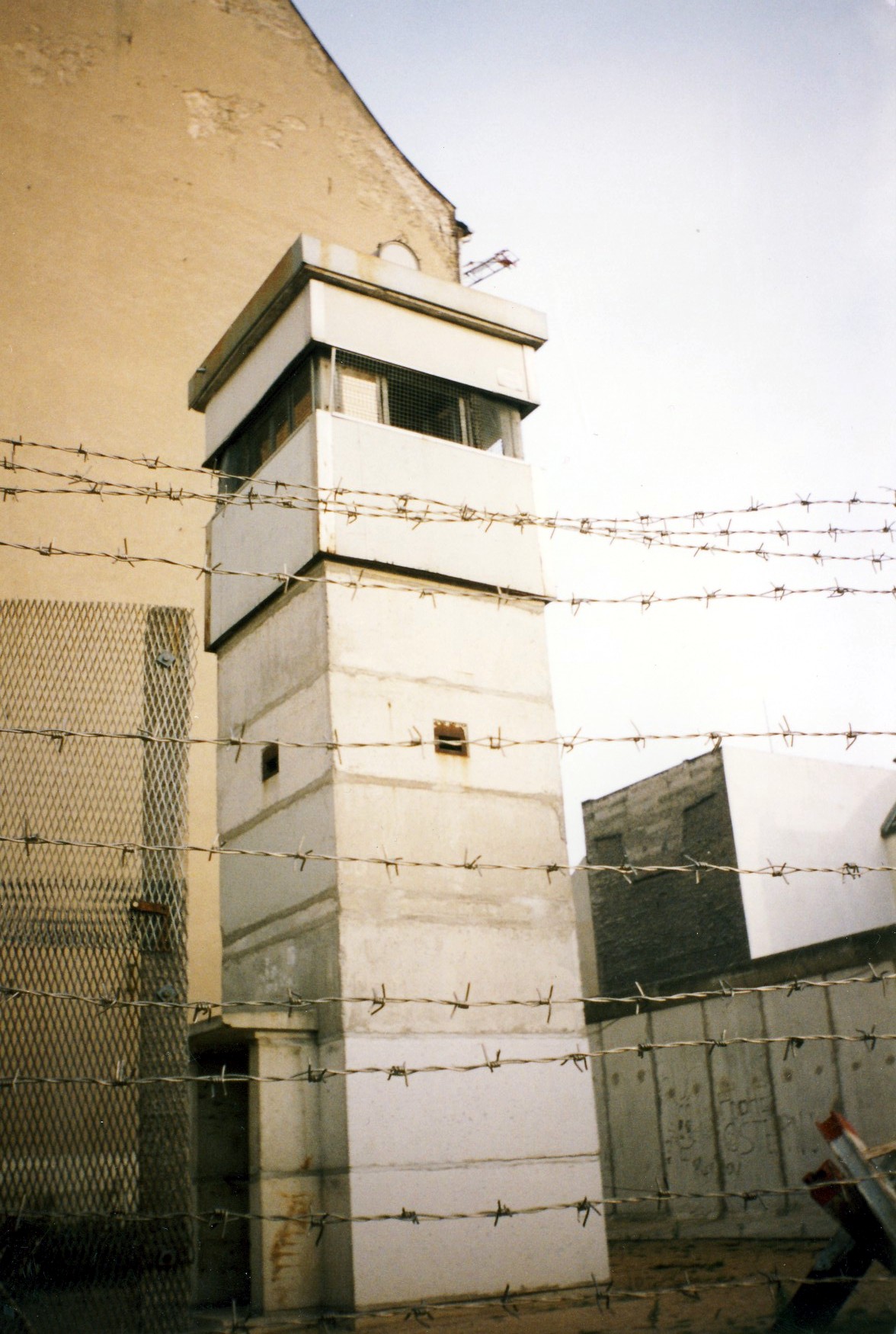
The Berlin Wall was breached on 9 November 1989 following both criticism and demonstrations from an Eastern bloc population growing in confidence and complaining about the failed economic policies, and Gorbachev’s principles of openness and reform. Borders between Hungary and Austria had been opened earlier in the year, seeing thousands of people flooding west so it was not a complete surprise when it happened. However the physical symbolism of the Berlin Wall made it a focal point for celebration.
Some memories of November 1989
I travelled to Berlin a couple of weeks later after seeing the news reports on TV though sadly I have no photos from that first trip. People were still partying, east Berliners were still queuing at post offices for the West German government’s gift of 100DMs (Begrüßungsgeld; welcome money) and I bought a hammer and chisel off someone with which to hack off chunks of Berlin Wall as souvenirs (you had to get the chisel behind the steel reinforcement bars and then pull on them – hacking at the wall just resulted in flakes of concrete chipping off).
BELOW; This is how I remember the Berlin Wall. Robin McMorran’s 1985 photos, this one taken at Potsdamer Platz. Graffiti covered concrete, tram lines disappearing under the wall where streets were cut in two… Hover your cursor over the image to scroll through other photos in the set.
BELOW; a couple of chunks of Berlin Wall which I hacked off somewhere near Potsdamer Platz, November 1989

BELOW; Checkpoint Charlie, photographed in 1987, image from wikipedia commons. This is the same spot as in the lead photo above and the photo I took further below. This was how the border control looked when I passed through in November 89
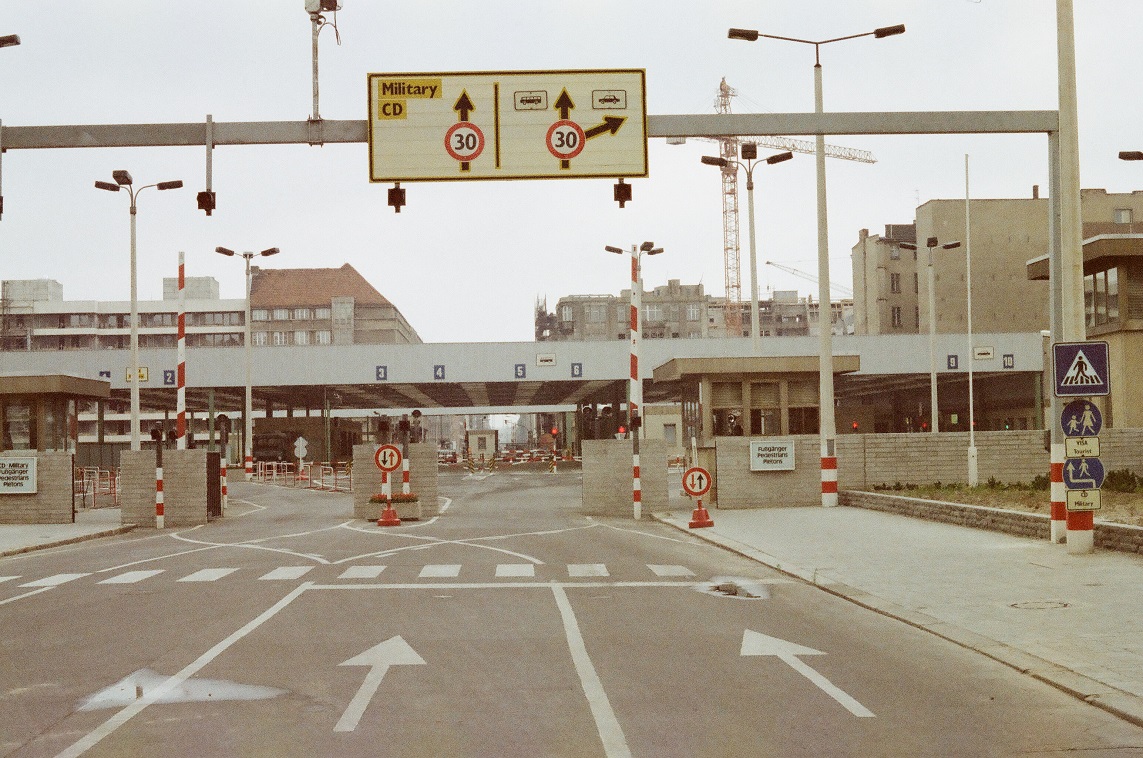
BELOW; Checkpoint Charlie during a second visit to Berlin a couple of years after the wall came down.

BELOW; How the scene looks now.

I traveled to the east one day, through Checkpoint Charlie, which by then was a via a building on the eastern side, straddling Friedrichstrasse. My passport was checked three times, my bag searched twice and I lost count of the same questions I was repeatedly asked – and this two weeks after the wall was opened. I also had to change an amount of Deutschmarks for some worthless Ostmarks, which could not be changed back.
I walked up along Mauerstrasse and recall seeing a ruined church which had not been cleared since the Battle of Berlin nearly 45 years earlier; the timbers from the roof lay upon the ground, covered in moss and there was a tree growing out of the ruins. Bullet holes were everywhere in the walls. They are still there now, but most have been neatly filled in.
I had flown into Berlin Tegel with DanAir but hitch-hiked out along the East German Transit Route. Westerners had to stay in their vehicles, a bit like visitors to Knowsley Safari Park but without the baboons, and could not deviate from the transit route.
My guide book for hitching around Europe was Simon Calder’s ‘Europe – A Manual For Hitch-Hikers’ I still have a copy though it is not my original copy – that one fell apart after much thumbing. The guide told hitchers which bus or tram to get to a particular spot which would be good for hitching a ride. Calder’s entry for hitching out of West Berlin and on to West Germany advises hitchers to make their way to the Dreilinden frontier post and “stand by the hitchers’ railings. Invariably crowded. Sign pref. *** Do not accept a lift that is not going all the way through to West Germany, Poland or Czechoslovakia. Non-residents of West Berlin must pay 5DM for a transit visa through East Germany”
The three asterisks note Calder’s opinion that this was a good spot for hitch-hiking. In fact, he rated it as the best in Europe. The worst was at Lyon in France on the A6, another place I found myself but that’s another story.
I was offered a lift in no time and at sunset passed through the border control where my passport, once stamped, traveled along a sealed conveyer to another checkpoint further along before being checked again and returned to me.
BELOW; One of my few souvenirs of November 1989; visa stamp from Checkpoint Bravo

The journey west through the increasing gloom was surreal; out of the night fog emerged the wrecks of east European lorries and cars that had been the victims of accidents but left on the side of the road rather than being cleared away and at some point we stopped at a service area which was for westerners only.
Some sources
BOOKS
The Berlin Wall, 13 August 1961 – 9 November 1989, Frederick Taylor, 2006
Berlin 1961: Kennedy, Khrushchev, and the Most Dangerous Place on Earth, Frederick Kempe, 2012
Cold War, Jeremy Isaacs & Taylor Downing, 2008
WEB
Death Strip: Berlin Pays Tribute to Last Person Shot Crossing Wall
PHOTO
Transit route map used with permission from
German History Documents
Berlin map, diagram showing attempted escapes, the image of Khrushchev and the 1987 photo of Checkpoint Charlie are all from Wikipedia commons
The photos of the stand off between US and Soviet tanks courtesy of the Cental Intelligence Agency
5 comments on “Checkpoint Charlie”
Leave a Reply Cancel reply
Image Information
-
Full Size: 1079×648px
Aperture: f/5.6
Focal Length: 18mm
ISO: 200
Shutter: 1/100 sec
Camera: NIKON D3200

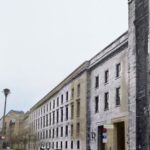
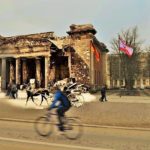
Hi Ian . This is fabulous . Its brought back some memories of our visit last year to the former East Germany at Rostock …..the bomb damage from our extensive bombing of the port and more relevent our visit to a preerved Stasi gaol . It was very sobering and some of your shots of the wall and the watchtowers etc are reminiscent of it .
Hi Paul, thanks. Rostock sounds like an interesting place to visit. You’d love Berlin!
cheers for the bit of the wall ian! Your websites really cool and im gonna reccommend for school- charlie {marks son}
Hi Charlie, I’m pleased you are interested in this history. I had loads of bits of Berlin wall from my first visit there. Gave ’em all away till there were just a couple of bits left – you have one which had been sat forgotten in a drawer for years, and I have the other as a souvenir. I hope you get to Berlin one day, there’s loads to see.
Ian
I visited Berlin early 80 and just as the wall was coming down. got my ost marks and bits of the wall. priceless